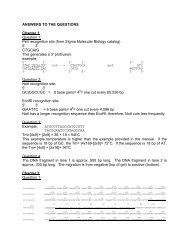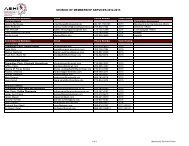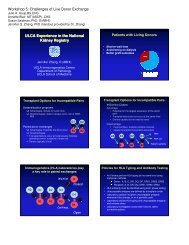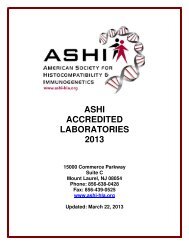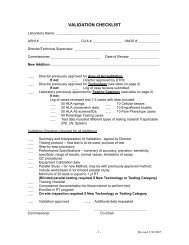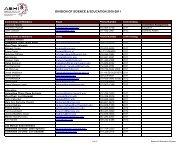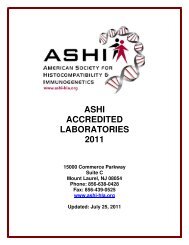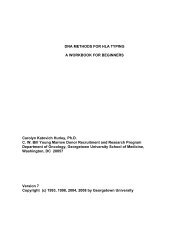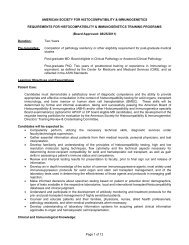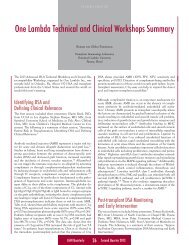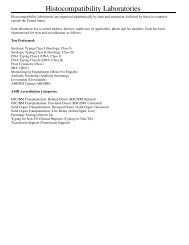36-PRE-THINKING THE ROP TRAYS IN REGION 1.Maureen M. Miller, Tod V. Alberghini, Michael Rewinski, Trish Michalski, Laurine Bow. TransplantImmunology Laboratory, Hart<strong>for</strong>d Hospital, Hart<strong>for</strong>d, CT, USA.Aim: To understand the usefulness and cost of creating and exchanging serum trays within Region 1. In<strong>2010</strong> CTOP stopped exchanging sera trays monthly with MAOB and switched to exchanging sera quarterlyfrom actively listed patients with a CPRA of greater than 50%. Do we need to share sera this often or canwe stop sharing sera all together?Methods: To expedite kidney allocation, Region 1 has agreed that each OPO lab must generate a list of thetop15 patients with a negative crossmatch <strong>for</strong> each deceased donor. The frequency of using exhange traydata was assessed by reviewing deceased donor kidney matches. All of the deceased donor kidney matchesin 2<strong>00</strong>9 from CTOP and donors from MAOB from 10/1/09 until 3/31/10 were reviewed in UNET.Results: In 2<strong>00</strong>9 CTOP had 36 deceased donor kidney matches. MAOB crossmatch results were needed<strong>for</strong> the kidney allocation in 26/36 (72%) kidney matches. MAOB had 104 deceased donors with kidneymatches in the six months reviewed and only once (1%, 91% CPRA, patient subsquently transplanted withnegative flow crossmatch) was the exchange tray data used in kidney allocation. This data mimicks MAOBdata from 2<strong>00</strong>7-2<strong>00</strong>9 presented regionally. The cost of the exhange trays <strong>for</strong> CTOP is approximately $25<strong>00</strong>every six months. This does not take into account the cost to run the trays <strong>for</strong> each donor which wouldinclude additional tech time and reagents.Conclusions: The low usage of the CTOP exchange tray data by MAOB suggests that they could beeliminated to cut costs. However, since data from the MAOB trays were used by CTOP 72% of the time,there usage should be continued. The difference in effectiveness of exchange tray use is most likely due tovarying numbers of patients on the list, antigen assignment vairation and local organ acceptance criteria <strong>for</strong>ECD and DCD donors.37-PUNACCEPTBLE ANTIGENS: HOW ARE THEY WORKING?Maureen M. Miller, Tod V. Alberghini, Michael Rewinski, Trish Michalski, Laurine Bow. TransplantImmunology Laboratory, Hart<strong>for</strong>d Hospital, Hart<strong>for</strong>d, CT, USA.Aim: Determine if unacceptable antigens listed in UNET predict patients who should have a negative Tand B cell crossmatch against a particular donor. In 2<strong>00</strong>9 the unacceptable antigens were reviewed when apatient was listed in UNET and then twice a year. An antibody must be detected in two different samplesby two different detection methods to be listed in UNET as unacceptable.Methods: Deceased donor kidney matches from 2<strong>00</strong>9 were analyzed. Patients with a CPRA of ≥10% in thetop 15 crossmatch results on each kidney match were reviewed. Patients from CTOP had T and B cellcytotoxic crossmatches per<strong>for</strong>med primarily and T and B cell flow crossmatches as needed, based on ourlab’s policy. Patients from MAOB had only T cell cytotoxic crossmatch per<strong>for</strong>med.Results: 36 deceased donor kidney matches were reviewed. Of the 540 total crossmatches <strong>for</strong> the top 15patients on each list, 135 (25%) were patients with a CPRA of ≥10%. 76 of these were patients listed withinCTOP and were evalutated further. 24/76 (32%) of the patients with CPRA >10% had a T and/or B cellpositive crossmatch. The CPRA ranged from 12-99%. 52/76 (68%) of the patients had a negativecrossmatch. Their CPRAs ranged from 10-94%. 8/24 (33%) of the patients with an unexpected positivecrossmatch had donor specific antibodies identified by only one antibody detection method. Many of theantibodies were identified by Gen-Probe Luminex ID assays but were not confirmed by either Gen-Probeor One Lambda Single Antigen assays. Another 8 (33%) had donor specific antibodies but did not havetheir unacceptable antigens updated in UNET. The remaining 8 unexpected positive crossmathces weremostly likely due to C,DP or low levels of antibodies, possibly IgM.Conclusions: Unacceptable antigens do aid in the kidney allocation process. Since they play such animportant role more frequent review is necessary to accurately report them to UNET.38-PSEROLOGIC SUBTYPES OF DQ7 SUGGESTED BY PRINCIPAL COMPONENT ANALYSIS OFSINGLE ANTIGEN SCREENING DATA.
Nabil Mohsin, Isabelle G. Wood, Indira Guleria, Edgar Mil<strong>for</strong>d. Medicine, Brigham Hospital, Boston, MA,USA.Aim: Serum is often tested <strong>for</strong> antibodies using single HLA antigens as targets. WHO serologic entities areused to specify antibodies. Investigators have found sera which appear to react selectively with one or morealleles within a WHO specificity, but these have not been well defined. Methods <strong>for</strong> systematicallysearching <strong>for</strong> such new antibody specificities are needed.Methods: We analyzed <strong>27</strong>50 sera from 1215 patients on Class II single antigen beads (One Lambda) usinga Luminex plat<strong>for</strong>m. We used Principal Component Analysis (PCA), a statistical method to find distinctpatterns of reactivity in multivariate space which account <strong>for</strong> the observed data.Results: For the five DQ7 beads, three principal components accounted <strong>for</strong> 99.3% of the MFI variance.Eigenvectors from PCA analysis showed the relative contributions of the beads to eachcomponent.[table1]The first component represented the 88.8% of sera which reacted equally with all of thefive alleles. The second component accounted <strong>for</strong> 9.2% of the data in which (DQA*03:01 DQB*03:01) hasa distinct pattern of reactivity from the other alleles. The third component, 1.3% of the data, were sera inwhich (DQA*03:03 DQB*03:01) had a unique pattern of reactivity.Conclusions: PCA is a powerful tool to identify candidate sera which can be used to detect new serologicalspecificities and might yield new WHO antigen definitions. The data suggests three serologic subtypeswithin DQ7.39-PANALYSIS OF A NEW CELL PRESERVATIVE FOR FLOW CYTOMETRIC CROSSMATCHES.Megan Moran, Patricia Brannon, Gebel Howard, Bray Robert. Pathology, Emory University, Atlanta, GA,USA.Aim: The importance of cell viability <strong>for</strong> crossmatching has increased, in part, due to the growth of paireddonor exchange programs. In this study we compared EDTA and ACD to the new Streck Cell Preservative(SCP). Samples were tested at day 1 and day 5 <strong>for</strong> antigen expression, viability and per<strong>for</strong>mance in astandard flow cytometric crossmatch.Methods: Peripheral blood from five healthy volunteers was collected into tubes containing ACD, EDTAor SCP and stored at room temperature. Mononuclear cells were isolated on day 1 and day 5 via ficollhypaqueseparation. Cell counts were per<strong>for</strong>med and viability assessed. A flow crossmatch was per<strong>for</strong>medusing two negative and one positive control sera.Results: At day 1 and 5, cell viabilities from all subjects were comparable (>98%) <strong>for</strong> all preservatives.SCP appeared to yield better separation and there was less red cell contamination compared to ACD orEDTA. In addition, light scatter was better preserved in the SCP tubes. However, cells from the SCPshowed significantly higher background fluorescence compared to ACD or EDTA. The high backgroundfluorescence did not affect the over all delta-MCF or MESF. In contrast, ACD and EDTA cells showed lowbackground fluorescence on day 1 and day 5 but, light scatter deteriorated, compromising the ability toidentify and gate lymphocytes. Nonetheless, there were no differences in crossmatch results <strong>for</strong> days 1 or 5.Conclusions: Peripheral blood collected into SCP, ACD, or EDTA yielded comparable results in the flowcrossmatch. Although the SCP tubes did appear better at preserving light scatter properties, the highbackground fluorescence florescence may be troublesome. While both ACD and EDTA showed loss oflight scatter integrity, they per<strong>for</strong>med similarly in the crossmatch. In conclusion, ACD and EDTA areacceptable preservatives <strong>for</strong> shipping whole blood <strong>for</strong> up to 5 days. While SCP may be used, highbackgrounds will be a challenge <strong>for</strong> analysis.40-PDEFINING CUT-OFF FOR THE LUMINEX MFI THAT CAN PREDICT THE FLOWCYTOMETRIC CROSSMATCH (FCXM) RESULTS.Omar Moussa 1 , Howard M. Gebel 1,2 , Robert A. Bray 1,2 . 1 Pathology and Lab Medicine, Medical Universityof South Carolina; 2 Pathology, Emory University.Aim: At present, the definition of “clinically relevant” HLA antibody is the center of much debate. Formany centers clinical relevance is defined as producing a positive crossmatch while <strong>for</strong> other centersrelevance is defined by the presence/absence of donor-directed antibody and clinical outcomes. Solid phase
- Page 1 and 2: Monday, September 27, 20102:00 PM -
- Page 3 and 4: 5-ORTWO CASES OF DONOR SPECIFIC ANT
- Page 5 and 6: Monday, September 27, 20102:00 PM -
- Page 7 and 8: Results: PHA-induced mRNA expressio
- Page 9 and 10: conjugated IgM (BD Biosciences), Ig
- Page 11 and 12: Methods: Peripheral blood and endom
- Page 13 and 14: Aim: NK cells have an established r
- Page 15 and 16: Methods: Sera (n=22) were tested fo
- Page 17 and 18: expression on lymphocytes, we hypot
- Page 19 and 20: Conclusions: Clean SA beads can eli
- Page 21 and 22: goal is to re-examine our previous
- Page 23 and 24: Aim: There is increasing evidence t
- Page 25 and 26: esult in poor graft survival. The g
- Page 27 and 28: Aim: Pronase treatment eliminates i
- Page 29: 34-PCLINICAL AND PATHOLOGICAL SIGNI
- Page 33 and 34: donor/recipient pairs for transplan
- Page 35 and 36: and tested in the DynaChip assay fo
- Page 37 and 38: average difference between Ave and
- Page 39 and 40: Conclusions: The XM-One assay can b
- Page 41 and 42: 59-PCYTOTOXIC AND NON-CYTOTOXIC ANT
- Page 43 and 44: data suggests that DTT pretreatment
- Page 45 and 46: Bhavna Lavingia 1 , Chantale Lacell
- Page 47 and 48: ATG INTERFERNCE IN SINGLE ANTIGEN L
- Page 49 and 50: 75-PPREFORMED LOW REACTIVE ANTI-HLA
- Page 51 and 52: Sabarinathan Ramachandran 1 , Naohi
- Page 53 and 54: 83-PALLELIC DIVERSITY OF KIR2DL4 AN
- Page 55 and 56: São Paulo, Brazil; 3 Commissariat
- Page 57 and 58: 91-PCHARACTERIZATION OF COMMON AND
- Page 59 and 60: Conclusions: The extensive diversit
- Page 61 and 62: 99-PPOTENTIAL COMMON NOVEL ALLELES
- Page 63 and 64: 103-PTOWARDS A FUNCTIONAL HLA-DPB1
- Page 65 and 66: 107-PWHOLE GENOME AMPLIFICATION (WG
- Page 67 and 68: 111-PLOSS OF MISMATCHED HLA IN FAMI
- Page 69 and 70: 115-PDONOR EPITHELIAL CELL CHIMERIS
- Page 71 and 72: Caucasian patients. MRs vary signif
- Page 73 and 74: Results: We obtained the total No.
- Page 75 and 76: cord blood and platelet transfusion
- Page 77 and 78: 131-PASSOCIATION OF IL-2-330(G/T) W
- Page 79 and 80: Institute, Children’s Hospital Oa
- Page 81 and 82:
Methods: To prove the robustness of
- Page 83 and 84:
populations.We studied the involvem
- Page 85 and 86:
amplicons generated from different
- Page 87 and 88:
Results: The sequence of the unexpe
- Page 89 and 90:
concentration of the Taq Polymerase
- Page 91 and 92:
160-PASSOCIATION OF HAPLOTYPES WITH
- Page 93 and 94:
164-PDETECTION OF A DE NOVO DONOR S
- Page 95 and 96:
168-PA NOVEL HLA-DQB1 ALLELE CONFIR
- Page 97 and 98:
172-PSCREENING FOR HLA-SPECIFIC ALL
- Page 99 and 100:
176-PIMPLEMENTATION OF THE WORLD HE
- Page 101 and 102:
epertoire of displayed ligands and
- Page 103 and 104:
mucosa. No other samples were avail
- Page 105 and 106:
Conclusions: In previously reported
- Page 107 and 108:
Conclusions: Our findings can demon
- Page 109 and 110:
Conclusions: In analyzing this data
- Page 111 and 112:
examined on microarrays from a huma
- Page 113 and 114:
Methods: Serial analysis of sera ob
- Page 115 and 116:
Conclusions: These new technologies
- Page 117 and 118:
allograft injury. Four of these 18
- Page 119 and 120:
A NOVEL HLA CLASS I SINGLE ANTIGEN
- Page 121 and 122:
Results: Approximately twice as man
- Page 123:
Methods: Molecular HLA typing was p



